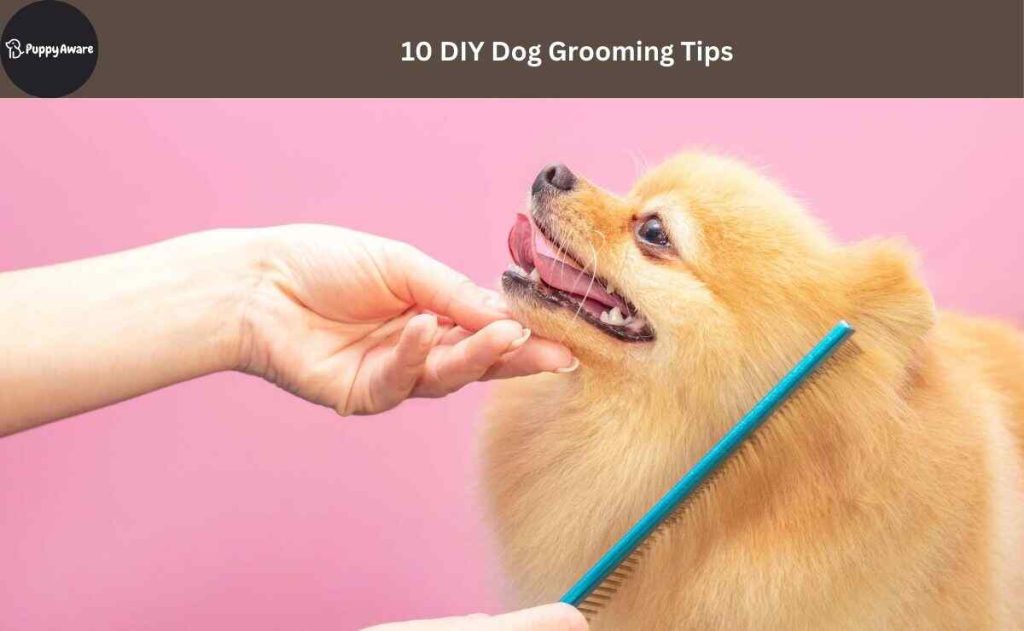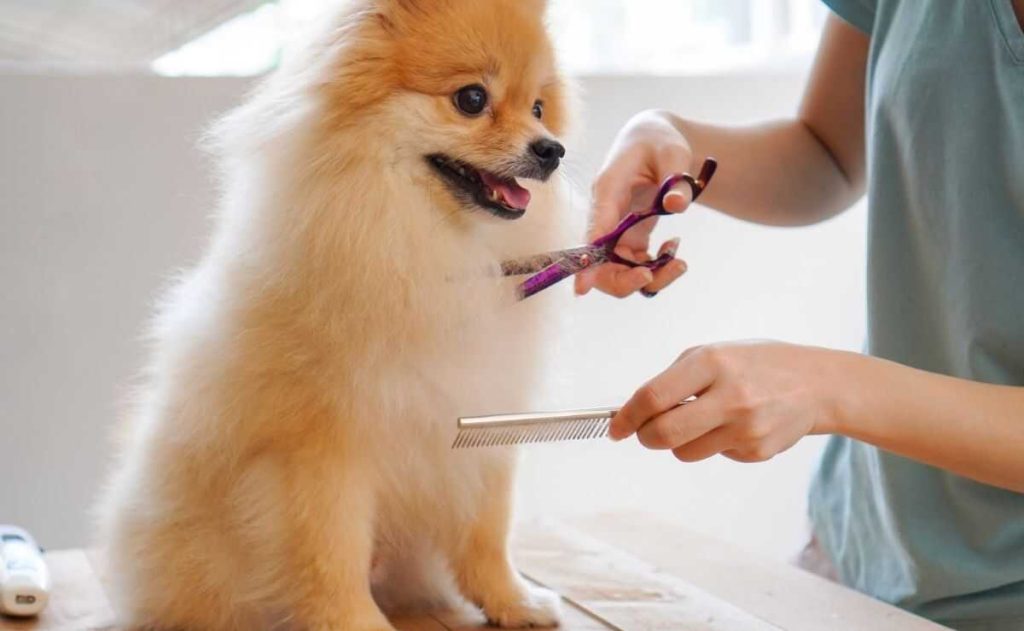Professional grade grooming at home matters. While professional groomers play a vital role in pet care, mastering at-home grooming can save money, strengthen your bond with your pet, and ensure consistent maintenance between professional visits.
In this comprehensive guide, we’ll explore expert-approved DIY dog grooming techniques that transform this necessary task into an enjoyable bonding experience. Whether you have a high-maintenance Poodle or a wash-and-wear Beagle, these tips will help you maintain your dog’s coat and overall hygiene like a pro.
Essential Tools for DIY Dog Grooming
Before diving into specific techniques, let’s ensure you have the right tools in your grooming arsenal:
| Tool Category | Essential Items | Optional but Helpful |
|---|---|---|
| Brushes & Combs | • Slicker brush • Metal greyhound comb • Pin brush | • De-matting tool • Rubber curry brush |
| Bathing Supplies | • Dog-specific shampoo • Conditioner • Non-slip mat | • Handheld sprayer • Grooming restraint |
| Trimming Tools | • Grooming scissors • Safety-tipped scissors | • Professional clippers • Blade coolant |
| Safety Items | • Styptic powder • First aid kit | • Grooming arm • Safety loops |
10 Essential DIY Dog Grooming Tips

Tip 1: Master the Art of Brush Selection
Different coat types require different brushing tools and techniques. Here’s a detailed breakdown:
| Coat Type | Recommended Brush | Brushing Frequency | Special Considerations |
|---|---|---|---|
| Short & Smooth | Rubber curry brush | 1-2 times weekly | Focus on removing dead hair and distributing natural oils |
| Double Coat | Slicker brush & undercoat rake | 2-3 times weekly | Extra attention during shedding seasons |
| Long & Silky | Pin brush & metal comb | Daily | Start from bottom layers working up |
| Curly/Woolly | Slicker brush & metal comb | Daily to every other day | Regular detangling to prevent mat formation |
Tip 2: Perfect Your Pre-Bath Routine
The secret to a successful grooming session lies in proper preparation. Here’s your pre-bath checklist:
Thorough Brush-Out
- Remove all tangles and mats before getting the coat wet
- Pay special attention to prone areas: behind ears, under collar, armpits, and groin
- Document any skin issues or abnormalities you find
Environmental Setup
- Prepare a non-slip surface in bathing area
- Gather all supplies within arm’s reach
- Adjust water temperature to lukewarm
- Consider using a shower head attachment for better rinsing
Tip 3: Master the Perfect Bath Technique
Bathing your dog isn’t just about getting them wet and soapy. Follow these professional techniques for the best results:
| Bathing Step | Technique | Common Mistakes to Avoid |
|---|---|---|
| Pre-Soak | Thoroughly wet coat down to the skin | • Skipping hard-to-reach areas • Using too hot/cold water |
| Shampoo Application | Start at neck and work downward | • Diluting shampoo incorrectly • Getting product in eyes/ears |
| Massage Technique | Use circular motions with firm pressure | • Rushing the process • Missing belly and paw pads |
| Rinsing | Rinse until water runs clear | • Leaving soap residue • Not protecting ears from water |
Pro Tip: Double-Washing Method
For exceptionally dirty or thick-coated dogs, implement the professional double-wash technique:
- First wash: Focus on breaking down dirt and oil
- Second wash: Deep clean and condition the coat
Tip 4: Tackle Drying Like a Professional
Proper drying is crucial for preventing skin issues and maintaining coat health:
Essential Drying Steps:
Towel Drying Technique
- Use pressing motions instead of rubbing
- Change towels when they become too wet
- Pay special attention to skin folds and creases
Air Flow Methods
- High-velocity dryer (if available):
- Keep nozzle 6-8 inches from skin
- Follow coat growth direction
- Use lower settings for sensitive areas
- Regular dryer alternative:
- Use cool or warm setting only
- Keep constant motion to prevent heat spots
- Brush while drying to prevent tangles
Tip 5: Perfect Your Trimming Technique
Even if you’re not doing a full haircut, knowing how to safely trim certain areas is essential:
| Area | Tool | Technique | Safety Considerations |
|---|---|---|---|
| Paw Pads | Safety scissors | Trim level with paw pads | Avoid pulling hair |
| Face | Rounded-tip scissors | Work slowly in small sections | Keep blade parallel to skin |
| Sanitary Areas | Safety scissors | Trim in good lighting | Be extra gentle |
| Nails | Nail clippers | Cut at 45-degree angle | Identify quick location first |
Nail Trimming Safety Protocol
Preparation
- Have styptic powder ready
- Ensure good lighting
- Position dog comfortably
Execution
- Trim small amounts at a time
- Watch for the quick (pink area)
- Reward frequently during process
Tip 6: Master Specialized Grooming Techniques
Different breeds require unique grooming approaches. Here’s a comprehensive breakdown:
Breed-Specific Grooming Chart
| Breed Type | Special Needs | Recommended Frequency | Professional Tips |
|---|---|---|---|
| Brachycephalic (Pugs, Bulldogs) | Clean facial folds | Daily | Use unscented baby wipes, dry thoroughly |
| Heavy Shedders (Huskies, German Shepherds) | Undercoat maintenance | 2-3 times weekly | Invest in an undercoat rake and high-velocity dryer |
| Wire-haired (Terriers) | Hand-stripping | Every 4-6 weeks | Learn to differentiate dead from live hair |
| Water Dogs (Poodles, Portuguese Water Dogs) | Mat prevention | Every 3-4 weeks | Regular cord maintenance or clip shorter |
Advanced Coat Maintenance Techniques
Line Brushing Method
- Part coat into horizontal lines
- Work from bottom to top
- Verify skin condition as you go
- Document any concerning areas
De-matting Protocol
- Start from outer edge of mat
- Use cornstarch to loosen tight mats
- Hold fur close to skin to prevent pulling
- Consider professional help for severe matting
Tip 7: Handle Sensitive Areas With Care
Proper technique for grooming delicate areas is crucial for both safety and effectiveness:
Sensitive Area Grooming Guide
| Area | Tools Needed | Technique | Warning Signs |
|---|---|---|---|
| Eyes | Tear stain remover, soft cloth | Gentle outward wiping | Redness, discharge |
| Ears | Ear cleaner, cotton balls | Clean visible areas only | Head shaking, odor |
| Teeth | Dog toothbrush, enzymatic paste | Circular motions at 45° angle | Bleeding gums, resistance |
| Paw Pads | Blunt scissors, paw balm | Trim between pads when dry | Cracking, excessive licking |
Expert Tips for Ear Care
- Never insert anything into the ear canal
- Use specially formulated cleaners
- Clean after swimming or bathing
- Monitor for signs of infection:
- Unusual odor
- Excessive wax
- Redness or swelling
- Frequent head shaking
Tip 8: Establish a Grooming Schedule That Works
Creating a consistent grooming routine is key to maintaining your dog’s coat and overall health:
Sample Grooming Calendar
| Frequency | Tasks | Duration | Notes |
|---|---|---|---|
| Daily | • Quick brush-out • Eye/face cleaning • Teeth brushing | 10-15 mins | Focus on problem areas |
| Weekly | • Full brush-out • Ear check • Paw pad inspection | 20-30 mins | Document any changes |
| Bi-Weekly | • Bath • Nail trim • Sanitary trim | 1-2 hours | Schedule when you’re not rushed |
| Monthly | • Full grooming session • Thorough skin check • Equipment maintenance | 2-3 hours | Take progress photos |
Seasonal Considerations
Summer Grooming Adaptations
- Increase frequency of brushing during shedding
- Monitor for hot spots
- Consider shorter clips for comfort
- Check for signs of fleas and ticks
Winter Grooming Modifications
- Maintain longer coat for warmth
- Focus on paw pad care
- Use moisturizing products
- Pay attention to snow/ice buildup between toes
Tip 9: Troubleshoot Common Grooming Challenges
Learn to handle typical grooming issues like a professional:
| Challenge | Prevention | Solution | When to Seek Help |
|---|---|---|---|
| Matted Coat | Regular brushing | Systematic de-matting | Severe matting affecting skin |
| Water Anxiety | Positive reinforcement | Gradual desensitization | Extreme panic reactions |
| Clipper Fear | Regular handling | Quiet clippers, treats | Aggressive responses |
| Skin Irritation | Proper product selection | Medicated solutions | Persistent problems |
Professional Tips for Difficult Dogs
Fear Management
- Start with short sessions
- Use high-value treats
- Take frequent breaks
- Maintain calm energy
Handling Techniques
- Support body weight properly
- Use gentle restraint methods
- Watch body language
- Know when to stop
Tip 10: Identify When to Call a Professional
While DIY grooming is excellent for routine maintenance, recognize situations that require expert intervention:
Professional Intervention Guide
| Situation | Warning Signs | Immediate Actions | Prevention Tips |
|---|---|---|---|
| Severe Matting | Skin irritation visible | Document affected areas | Maintain regular brushing |
| Behavioral Issues | Aggressive responses | Stop grooming immediately | Seek training assistance |
| Skin Conditions | Redness, scabs, hot spots | Photos for vet reference | Regular skin checks |
| Complex Cuts | Breed-specific styling needs | Research local groomers | Learn basic maintenance |
Essential Safety Tips and Best Practices

1. Emergency Preparedness
Always keep these items readily available:
First Aid Supplies
- Styptic powder
- Gauze and self-adhering bandages
- Antiseptic wipes
- Emergency vet contact
Safety Equipment
- Non-slip mats
- Proper restraints
- Good lighting
- Ventilation
2. Signs of Grooming Stress
Monitor your dog for these indicators:
- Excessive panting
- Whale eyes (showing whites)
- Shaking or trembling
- Lip licking
- Yawning repeatedly
Final Recommendations and Tips
- Cost-Saving Strategies
| Investment Area | Essential Items | Optional Upgrades | Expected Lifespan |
|---|---|---|---|
| Basic Tools | $50-100 initial | $200-300 professional | 1-2 years |
| Maintenance Products | $30-50 monthly | $80-100 premium | 2-3 months per item |
| Education Resources | Free online guides | $50-200 courses | Lifetime value |
- Long-Term Success Tips
Documentation
- Keep a grooming journal
- Take progress photos
- Track product effectiveness
- Note seasonal changes
Continuous Learning
- Join grooming communities
- Watch professional tutorials
- Attend workshops when possible
- Stay updated on new techniques
Quick Reference Card
Save this handy reference for your grooming toolkit:
| Quick Tips | Remember To | Never |
|---|---|---|
| Brush before bathing | Check water temperature | Force a frightened dog |
| Reward frequently | Clean tools after use | Skip safety precautions |
| Work systematically | Document problems | Rush through sessions |
| Stay calm | Take breaks as needed | Ignore signs of stress |
Conclusion
DIY dog grooming doesn’t have to be intimidating. With the right tools, techniques, and knowledge, you can maintain your dog’s appearance and health while strengthening your bond.
Remember to stay patient, be consistent, and always prioritize your dog’s comfort and safety. Start small, build confidence, and celebrate the small victories in your grooming journey.
Related Posts
